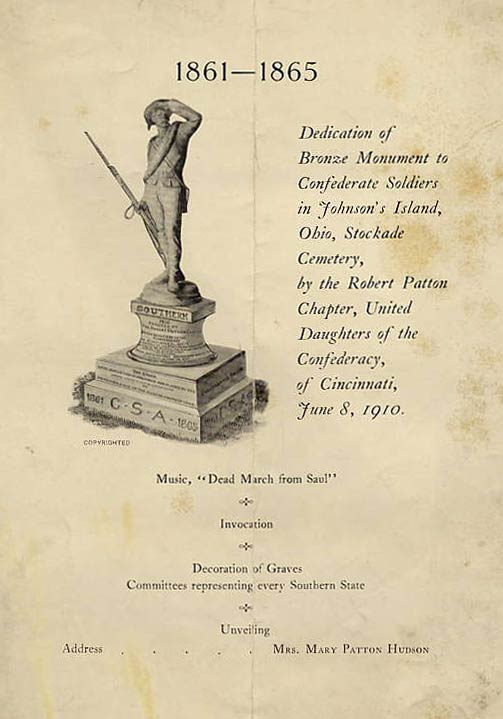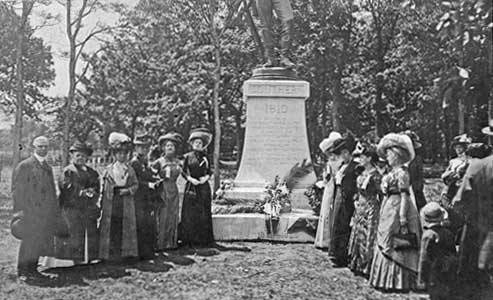Island History – Civil War Era
Confederate Cemetery
Visitors to Johnson’s Island often inquire about the number of prisoners buried in the cemetery. There are 206 graves marked with headstones. For many years this was the commonly accepted number. It was derived from a list compiled by the Sandusky Register and published in its May 12, 1890 edition. The exact number and location of the graves is not certain due to deterioration of the original wooden grave markers, as well as inaccurate records and incomplete lists.
However, in recent years, studies have been conducted which indicate there were more burials in the cemetery than the 206 previously mentioned. An Internet site claims there were 216 burials. Unfortunately, neither the author nor the reference sources are identified in the listing. A considerably higher number, 267 burials is recorded on two monuments, which were dedicated in 2003. This larger number includes several graves detected with the use of ground penetrating radar.
The information used for this and the following two paragraphs came from microfilm copies of the “Auxiliary Register No.3 Deaths” (Death Register). This list contains the names of 241 officers, soldiers, or civilians who perished on Johnson’s Island. The Death Register also includes the names of 25 prisoners whose remains were removed from the island and sent to either their families or friends. However, it shows no disposition of the remains for 14 of the 241 names listed.
According to the above register, the first Confederate Soldier to die on Johnson’s Island was 1st Lieutenant R. M. Ray who was laid to rest on May 25, 1862. Ray was captured at Fort Donelson on February 16, 1862 and came to the island on April 9th with the first group of Confederate soldiers. Forty-six days later he died of typhoid fever. The last prisoner to be buried in the cemetery is J. L. Hood, Adjutant of the 59th Virginia Infantry. He was buried on May 2, 1865.
There were two prisoners fatally wounded by the guards. Lieutenant Elijah Gibson, 11th Arkansas Infantry, was mortally wounded on August 9, 1862. A guard shot him “because he failed to obey a rule”. Gibson was out of his prison block after curfew and refused to obey an order to return to the block from which he had come. The other prisoner known to have been killed by a guard was John B. Bowles who was shot on December 12, 1864 while attempting to escape by scaling the stockade wall. Bowles was a 2nd Lieutenant of the 3rd Kentucky Regiment and was captured at Cynthiana, Kentucky on June 12th, 1864.
In September 1889, a visiting group of farmers and newspapermen on a sight-seeing tour of Ohio visited the cemetery. After seeing the neglected cemetery and the many obliterated grave markers, the group took quick action to replace the markers. The new markers were made of Georgia marble. All of the markers were replaced regardless of the home state of the deceased person. The citizens of Georgia raised money from donations. Various railroads absorbed the cost of transporting the markers to Sandusky. Leonard B. Johnson furnished teams of horses to haul the markers from the Johnson’s Island dock to the cemetery. The setting of the headstones was completed in May 1890.

There are three monuments in the cemetery that are dedicated to the men who still rest on Johnson’s island. The first and largest monument was dedicated on June 8, 1910. Several hundred people from the north and south attended the dedication of the Bronze Memorial. The Robert Patton Chapter of the United Daughters of the Confederacy commissioned Sir Moses Ezekiel to create a memorial for those who were buried on Johnson’s Island. As a V.M.I. cadet, Sir Ezekiel fought at the battle of New Market, Virginia. Two days after the battle, a classmate of Ezekiel’s died in his arms. After the War Between the States, Ezekiel created many monuments, including the Memorial to Confederates buried in Arlington National Cemetery.
The dedication of the bronze monument was a very important event for Johnson’s Island and Sandusky, Ohio. Stories about the event filled the front page of the Sandusky Register for two days. Several hundred Confederate and Union veterans with their wives and families attended the dedication on June 8, 1910. General George Washington Gordon who was imprisoned on the island gave the main address. A ferryboat worked the entire day transporting visitors to and from the island. Perhaps by mere coincidence, the boat used was the R. B. Hayes, named after President and Union General, Rutherford B. Hayes.
The remaining two monuments were dedicated on June 21, 2003 by the Ohio Division of the United Daughters of the Confederacy and the Lieutenant General James Longstreet Camp 1658, Sons of Confederate Veterans. These monuments provide additional information about the remains of those buried on Johnson’s Island. The text on the monuments indicates that 267 sets of remains were located. A diagram on the monuments shows what is believed to be the additional grave locations.

The Robert Patton Chapter of the United Daughters of the Confederacy purchased the cemetery on Mach 1,1905, from Charles Dick and James H. Emrich. The iron fence and gates were installed in 1912. Finally on June 5, 1932, the Federal government took over ownership of the cemetery. The property is maintained by the Veteran’s Administration.
According to “The Civil War Reminiscences Of General M. Jeff Thompson”, (Morningside Press), General Thompson was involved with documenting the location of prisoners already buried in the cemetery and keeping track of the new burial locations. General Thompson was on Johnson’s Island from September 13, 1863 until February 18,1864. During this time he mapped the existing grave locations and laid out and mapped future gravesites. Perhaps someday this map will be located and made available to help determine the names of those buried in the graves marked “UKNOWN”.
